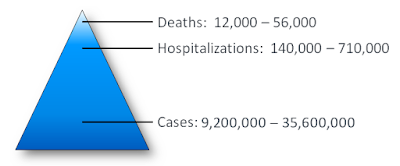#13,694
While the arrival of influenza season is a given every winter, each season has its own patterns and personality. Last year, we saw the worst flu season in decades; nearly 950,000 hospitalizations and roughly 80,000 deaths in the United States alone.
Among these 80,000 fatalities the CDC estimates more than 10,000 were working age adults, and > 600 were children under 18 (see CDC: The Estimated Burden Of Last Year's Flu Season).The CDC has an `expected range' of seasonal influenza hospitalizations and deaths (see chart below), but some years can fall outside of these ranges. As bad as last year was, the 2011-2012 flu season was exceptionally mild (see CDC: The Close Of A Mild Season), barely leaving a blip on the chart.
The point being, while we can predict the flu will return, we can't predict how severe, or how prolonged, flu season will be. And the flu season we see in North America and differ greatly from the flu season seen in Asia, Europe, or the Middle East.
We do know that H3N2 dominated seasons - as we saw last year - tend to be more severe, and are particularly hard on those over the age of 65. H1N1 and Influenza B seasons tend to be less severe, but often impact younger adults and children more.Last week Canada announced an early start to their flu season (see Canada FluWatch Week 45: Early Flu Affecting Younger Age Groups), noting that the dominant strain was H1N1, and that younger age-groups were being affected more than in previous seasons.
While this week's FluView report from the CDC has been delayed by our truncated Thanksgiving Week, so far reports suggest flu activity remains low in the United States.
That, however, is apt to change over the next few weeks as flu ramps up to our north, and holiday travel and a return to school on Monday helps spread the virus.Yesterday Public Health Canada released their latest FluWatch report, indicating that the trends we saw last week continue.
FluWatch report: November 11, 2018 to November 17, 2018 (Week 46)
Overall Summary
- Influenza activity continued to increase in week 46. The influenza season has started earlier than in recent years.The number of regions in Canada reporting localized influenza activity in week 46 increased slightly compared to the previous week.
- Influenza A is the most common influenza virus circulating in Canada, and the majority of these viruses are A(H1N1)pdm09.
- The number of influenza-associated hospitalizations continued to increase in week 46. In particular, the number of pediatric hospitalizations is significantly higher than in recent years.
- The number of influenza outbreaks remains within expected levels. However, the settings in which outbreaks have been reported this season suggests that younger age-groups are being affected more than in previous seasons.
Laboratory Confirmed Influenza Detections
In week 46, the following results were reported from sentinel laboratories across Canada (Figure 2):Since what happens with flu in Canada is a fairly reliable indication of what is to come to the United States, if you've been hesitating on getting a flu shot, now would be an excellent time to pull the trigger.
To date this season 2,063 laboratory-confirmed influenza detections have been reported (Figure 3):
- The percentage of tests positive for influenza continued to increase to 13.8% of tests positive.
- The percentage of tests positive for influenza A is higher for this time of year compared to the same period during the previous eight seasons.
- In week 46, 642 laboratory detections of influenza were reported, of which 99% were influenza A.
To date this season, detailed information on age and type/subtype has been received for 2,069 laboratory-confirmed influenza cases (Table 1):
- 98% have been influenza A
- Among the 1,203 influenza A viruses subtyped, 91% have been A(H1N1)pdm09
(Continue . . . )
- Adults 20-44 years of age represent the largest proportion of cases (25%), followed by individuals 5-19 years of age (20%).
As an added bonus, the flu vaccine is generally much better at protecting against H1N1 than its H3N2 cousin.But whether you get the flu shot or not - particularly given the number of non-influenza viruses out there - now is also the time to start consistently practicing good flu hygiene (covering coughs, washing hands, staying home if you are sick, etc.).

